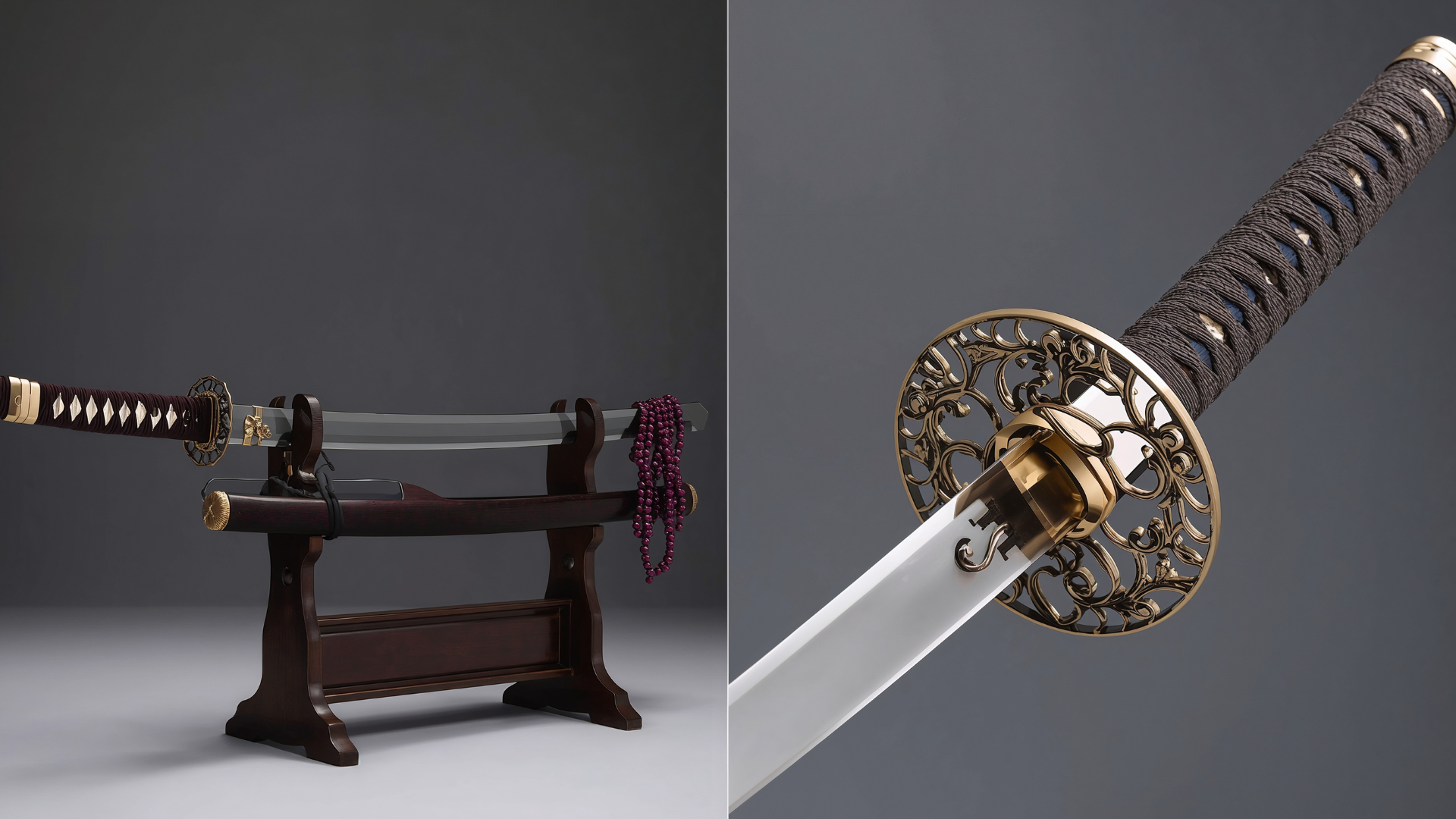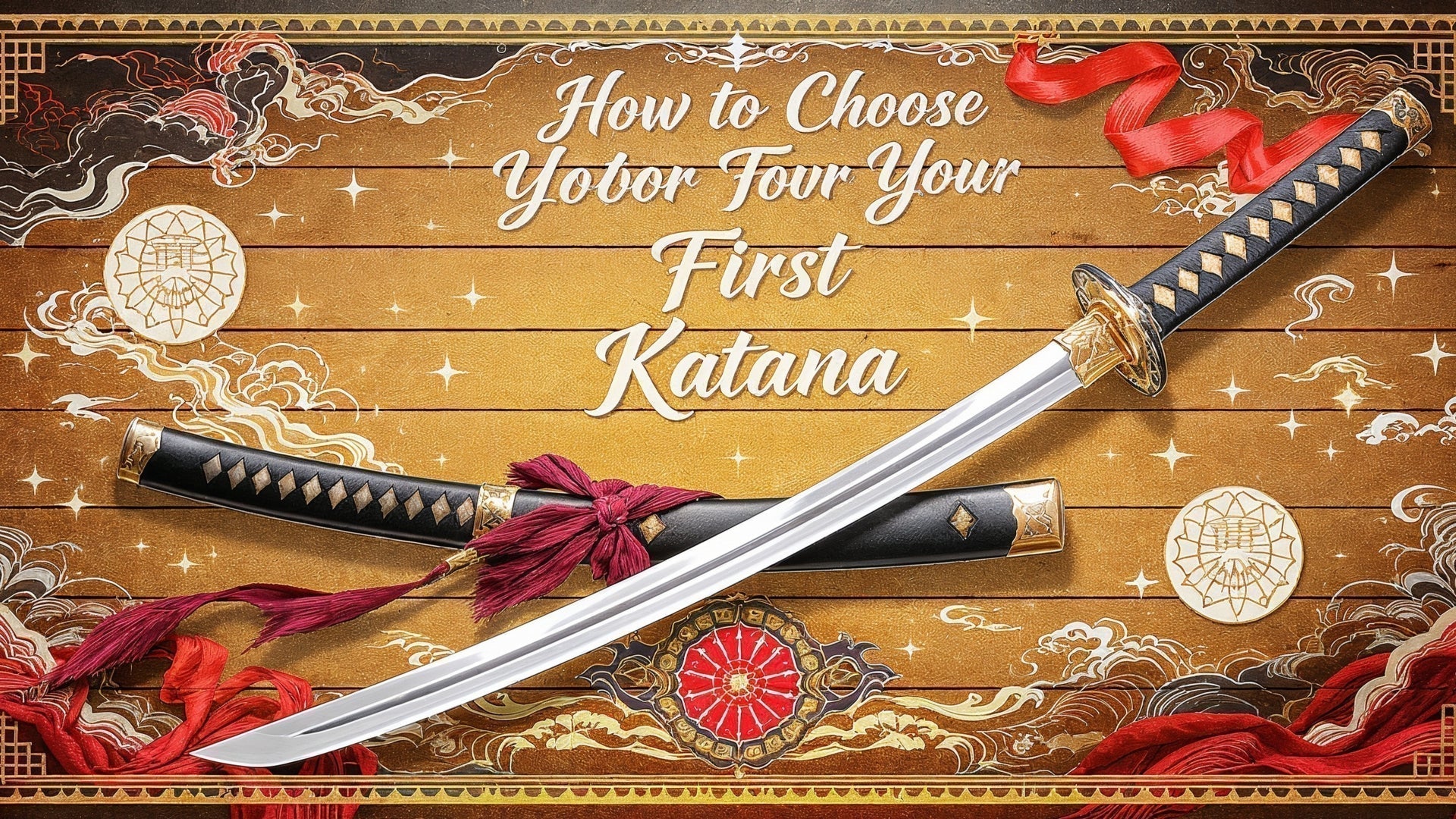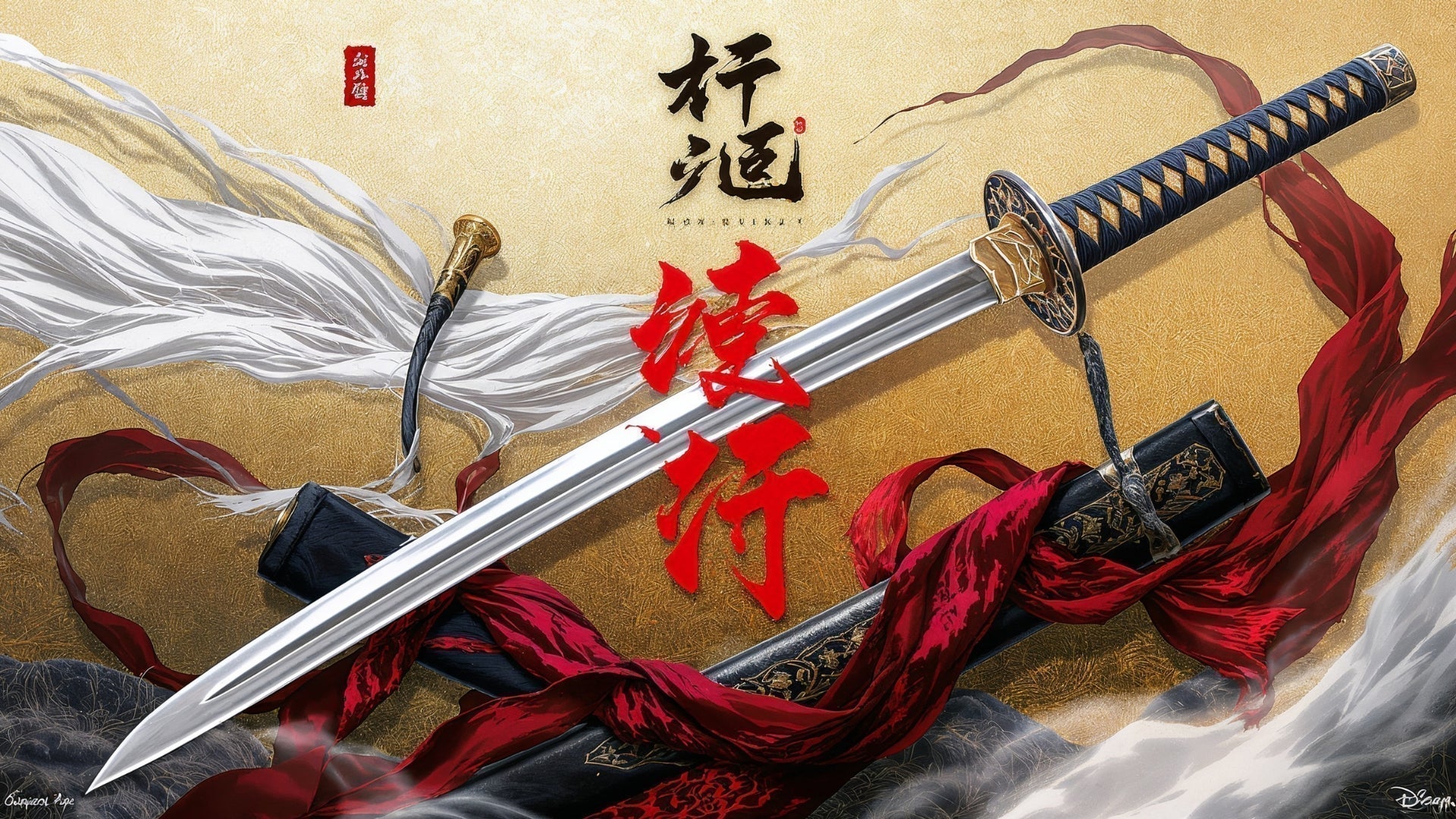The katana has fascinated people for centuries. Known as the weapon of the samurai, it embodies power, precision, and artistry. Today, katanas are sold worldwide—but not all are created equal. Some are purely decorative, while others are engineered for real cutting practice and martial arts use. This raises the key question: are katanas battle ready?
This definitive guide goes beyond marketing claims. You’ll learn exactly what “battle‑ready” means today, how construction affects safety and performance, how to spot red flags before you buy, what price ranges truly deliver, and how to care for a functional blade so it lasts a lifetime.
What Does “Battle Ready” Really Mean?
In modern usage, battle ready doesn’t mean “take it to combat.” It means the sword is fully functional and safe for controlled cutting when handled by a trained practitioner.
Core criteria of battle readiness
-
Full‑tang construction: The blade and tang are one continuous piece of steel that runs the full length of the handle (tsuka), secured by one or two mekugi (bamboo pegs).
-
Appropriate steel: High‑carbon or spring steel that can take and hold an edge.
-
Proper heat treatment: A hard edge with a tougher spine to resist chipping and catastrophic failure.
-
Sound mounting: A tight, rattle‑free tsuka, quality fittings, and a saya (scabbard) that retains the blade securely.
Bottom line: a battle‑ready katana is a tool, not a toy. Decorative swords are art pieces; functional swords are engineered for stress.

Anatomy That Matters (and Why)
A katana is a system—blade, tang, handle, and fittings all work together. Weakness in one area can make the whole sword unsafe.
-
Blade geometry (sugata): Most cutting katanas are 69–73 cm (27–29 in) nagasa with moderate sori (curvature) for draw efficiency. A poor geometry can make cuts feel sluggish or overly whippy.
-
Tang (nakago): Should be full‑profiled, not a skinny “rat‑tail.” The mei (signature) isn’t a safety factor; the shape and thickness are.
-
Handle (tsuka): A properly carved tsuka core (often honoki wood) should fit the tang precisely without epoxy. Samegawa (ray skin) and tight ito (wrap) improve grip and torsional control.
-
Mekugi: One or two tapered bamboo pegs hold everything together. They should seat firmly and be replaceable.
-
Fittings (koshirae): The tsuba (guard), fuchi/kashira (collar/pommel), and seppa (spacers) should be steel or solid brass—no pot metal that crushes or cracks.

Steel & Heat Treatment: A Deep Dive
Your blade’s steel and heat treat determine edge retention, toughness, and failure mode.
Common steels for functional katanas
-
1045: Entry‑level; can be functional if properly treated but edge retention is limited.
-
1060: Good balance of toughness and hardness; popular for beginners.
-
1095 / T10: High carbon; takes a keen edge and crisp hamon but can be chippy if mishandled.
-
5160 (spring steel): Excellent toughness and resilience; favored for heavy cutting.
-
L6 bainite (specialized): Exceptional toughness when heat‑treated correctly; premium and rare.
Heat treatment methods
-
Differential hardening (clay‑tempering): Creates a hard edge and a tougher spine; produces a natural hamon. Typical hardness: edge ~HRC 58–62, spine lower for shock resistance.
-
Through‑hardening: Uniform hardness; often tougher overall but lacks a natural hamon. Great for rough cutting.
Real vs fake hamon
-
A natural hamon has depth and activity; an acid‑etched or wire‑brushed hamon looks flat and uniform. A fake hamon is a cosmetic, not a performance, feature.
Safety note: brittle equals dangerous. A too‑hard, poorly tempered edge can chip or fracture under stress.
Build‑Quality Checklist (20 Quick Tests Before First Cut)
-
No handle rattle when shaken.
-
Ito wrap is tight, alternating, and immobile under thumb pressure.
-
Mekugi tap in/out securely; replace wood pegs if crushed.
-
Full‑tang confirmed by specs or disassembly (advanced users only).
-
Tsuba doesn’t shift; minimal play.
-
Seppa snug; no gaps.
-
Habaki seats flush; no blade wobble in the collar.
-
Saya retention: blade doesn’t fall out upside‑down; smooth draw.
-
Sight down the blade: no obvious twists or waves.
-
Edge line uniform; no flat spots.
-
Paper test: should cleanly slice printer paper along 10–15 cm without snagging (after light oil removal).
-
Balance point 12–15 cm from tsuba for most cutters.
-
Weight typically 1.0–1.3 kg (2.2–2.9 lb) depending on geometry.
-
No epoxy globs visible at the habaki/tsuka junction.
-
Fuchi/kashira tight; no hairline cracks.
-
Samegawa panels well‑seated, not peeling.
-
Ito diamonds even; menuki settled symmetrically.
-
No metal burrs along the mune or ha.
-
No lateral flex when gently hand‑loaded (do not bend test aggressively).
-
Oil film clean and even; no rust speckling.
Decorative Katana: Beautiful—but Fragile
Decorative (wall‑hanger) katanas are made to look good, not to work hard.
Common traits
-
Stainless blades that are brittle in impact.
-
Welded/rat‑tail tangs that can snap.
-
Pot‑metal fittings and hollow tsuba.
-
Painted or acid‑etched hamon; cosmetic only.
Use them for display, cosplay, or photo shoots—not for cutting. Misuse can result in catastrophic failure and serious injury.

Functional vs Decorative: Expanded Comparison
| Feature | Battle‑Ready Katana | Decorative Katana |
|---|---|---|
| Tang | Full tang, secured by 1–2 mekugi | Rat‑tail/welded, often hidden |
| Steel | 1060/1095/T10, 5160, L6 (properly heat‑treated) | Stainless steel (420/440) |
| Heat Treatment | Differential or through‑hardened | Minimal/unknown |
| Edge | Sharpened for cutting | Dull/thin, or dangerously brittle if sharp |
| Fittings | Brass/steel, tight koshirae | Pot metal, loose wraps |
| Target Rating | Tatami, goza, light bamboo (skill dependent) | None |
| Expected Longevity | Years with proper care | Display only |
| Typical Price | $200–$2,000+ | $50–$200 |
| Safety | Engineered for stress | Not safe for cutting |
The Role of Martial Arts (and the Right Tool)
-
Iaidō: Mostly iaitō (blunt alloy) for forms; advanced students may use shinken (live blades) with supervision.
-
Battōdō / Kenjutsu: Emphasis on draw, cut, and control—requires robust, well‑balanced shinken.
-
Kendō: Uses shinai (bamboo swords) and bokken (wood); not steel katanas.
-
Tameshigiri: Test cutting on tatami omote (goza), water‑soaked mats, and sometimes green bamboo. Start with soft, aligned targets; progress slowly.

Safety Protocols for Cutting Practice
-
Space & backstop: 360° clear zone; solid stand on level ground.
-
PPE: Eye protection recommended; no open‑toe footwear.
-
Spotter: Have a trained partner observe alignment and safety.
-
Technique first: Poor edge alignment (hasuji) chips blades—train with bokken/iaitō before shinken.
-
Never cut hard/dirty targets: No tree branches, metal, frozen bottles, or sand‑contaminated mats.
Pre‑Cut Inspection Routine (Every Session)
-
Remove oil and check the edge for micro‑chips.
-
Confirm mekugi are intact and seated.
-
Test saya fit; ensure clean draw.
-
Dry swing to feel for rattles or odd vibrations.
-
After cutting, clean debris immediately; re‑oil before storage.
Price Tiers: What You Actually Get
-
Under $200: Decorative or very basic through‑hardened 1045; safe for display only.
-
$200–$400: Entry‑level functional cutters (1060/through‑hardened); suitable for beginners on tatami.
-
$400–$800: Better fit/finish, 1095/T10 or 5160; some clay‑tempered options; reliable for regular tameshigiri with good technique.
-
$800–$1,500: Higher‑end production or semi‑custom; refined geometry, quality koshirae, consistent QC.
-
$1,500–$5,000: Custom builds or restored nihontō mounts; specialized steels/heat treats and premium fittings.
-
$5,000+: Art‑level nihontō by licensed smiths; primarily collectible, though fully functional.
Reality check: Materials + labor + QC cost money. If specs look too good for the price, be skeptical.
How to Evaluate Sellers (Without Brand‑Dropping)
-
Transparent specs (steel, heat treatment, geometry, weight, POB).
-
Clear return policy and warranty on defects.
-
QC photos or videos of the exact blade/hamon when possible.
-
Reputation in practitioner communities; real reviews from verified buyers.
Quick Legal Reminder (and Internal Linking)
Laws differ by country and city: ownership is often legal; public carry is frequently restricted. For details, see our complete guide: Are Katanas Legal? The Complete Legality Guide by Country. Always comply with local regulations.
Shipping, Storage & Insurance for Functional Blades
-
Shipping: Oil the blade lightly, secure the habaki, pad the kissaki, and box with rigid protection. Declare appropriately for customs.
-
Home storage: Edge‑up in the saya on a stable kake; 40–50% relative humidity; avoid leather sheaths.
-
Insurance: High‑value blades should be appraised and insured; keep invoices and provenance.

Common Myths—Busted
-
“Stainless is low‑maintenance and fine for cutting.” No—stainless is brittle; use high‑carbon or spring steel for functional use.
-
“Any sharp sword is battle ready.” Edge sharpness without proper tang and heat treat is dangerous.
-
“Clay‑tempered always beats through‑hardened.” Not always—through‑hardened spring steels can be tougher for heavy practice.
-
“More layers/folds mean stronger.” Folding is aesthetic and for historical impurity control, not a magic strength booster.
-
“Tight epoxy equals quality.” True quality is a precise mechanical fit, not glue.
Buyer Personas & Recommended Specs
-
Beginner practitioner: 1060 or 5160, through‑hardened, conservative geometry; 1 mekugi is fine, 2 preferred; $300–$600.
-
Regular tameshigiri: T10/1095 or 5160; clay‑tempered or tough through‑hardened; robust habaki; $600–$1,200.
-
Collector‑practitioner: Clay‑tempered with active hamon, premium koshirae; $1,200–$3,000.
-
Cosplayer/Display: Safe stainless or unsharpened alloy; $50–$200 (do not cut).
Extended FAQ (30+ Practical Questions)
1) Can I train with a decorative katana?
No. Decorative swords aren’t engineered for stress; they can snap or throw shards.
2) What’s the cheapest “real” katana I can safely cut with?
Around $200–$300 for a properly heat‑treated 1060 through‑hardened blade.
3) Is stainless steel ever battle ready?
No. It’s too brittle for impact cutting.
4) Do I need a full tang for safety?
Yes. Full tang with at least one bamboo mekugi is the baseline.
5) How sharp should a cutting katana be?
Sharp enough to slice paper and cleanly cut soaked tatami. Over‑thin edges chip easily.
6) Clay‑tempered vs through‑hardened—which is better?
Depends: clay‑tempered offers a hard edge (beautiful hamon) but may chip; through‑hardened spring steel is very tough.
7) Can I do tameshigiri on bamboo?
Not as a beginner. Start with tatami; progress to thin green bamboo with coaching.
8) How do I check if my tsuka is tight?
There should be zero rattle; ito should not shift under thumb pressure.
9) How often should I replace mekugi?
Inspect every session; replace at the first sign of crush, cracks, or looseness.
10) Are folded blades stronger?
Not inherently. Folding is mainly aesthetic today; heat treat matters more.
11) Can a battle‑ready katana be used for self‑defense?
Not recommended and often legally risky. Train for sport/practice, not self‑defense.
12) What targets are safe?
Soaked tatami/goza, clean pool noodles. Avoid wood, metal, or dirty materials.
13) How long will a functional katana last?
With proper care, decades—or centuries for quality blades.
14) My blade chipped—what now?
Stop cutting; consult a professional polisher. Don’t grind it yourself.
15) Can I use WD‑40 as oil?
No. Use choji or high‑grade mineral oil.
16) How do I store the sword?
Edge‑up in its saya on a stable stand; 40–50% RH; away from leather.
17) Do I need insurance?
Recommended for blades over your deductible or of historic value.
18) Are heavy blades better cutters?
Not automatically. Geometry and edge alignment matter more than raw mass.
19) How do I spot a fake hamon?
Flat, uniform “lines” with no activity are often etched/painted. Real hamon shows depth and variation.
20) What’s the safest way to test sharpness?
Paper slice test—never finger tests.
21) Why does my blade rust even though I oiled it?
Humidity swings or fingerprints under
Conclusion: Art and Tool, Know the Difference
A katana can be both a stunning work of art and a capable cutting tool—if it’s built for function. Understanding steel choice, heat treatment, tang construction, and solid koshirae lets you separate marketing fluff from real engineering. Buy smart, practice safely under instruction, and maintain your blade properly: you’ll preserve tradition, protect yourself, and get the performance you paid for.



Share:
How to Choose Your First Katana: Complete Beginner’s Guide